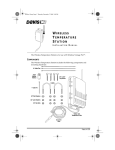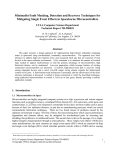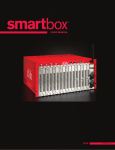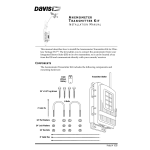Download Microprocessor fault-tolerance via on-the-fly partial
Transcript
!
Politecnico di Torino
Microprocessor fault-tolerance
via on-the-fly partial reconfiguration
Authors: Di Carlo S., Miele A., Prinetto P., Trapanese A.,
Published in the Proceedings of the IEEE 15th European Test Symposium (ETS), 24-28 May 2010,
Praga, CZ.
N.B. This is a copy of the ACCEPTED version of the manuscript. The final
PUBLISHED manuscript is available on IEEE Xplore®:
URL: http://ieeexplore.ieee.org/stamp/stamp.jsp?tp=&arnumber=5512759
DOI: 10.1109/ETSYM.2010.5512759
© 2000 IEEE. Personal use of this material is permitted. Permission from IEEE must be
obtained for all other uses, in any current or future media, including reprinting/republishing
this material for advertising or promotional purposes, creating new collective works, for resale
or redistribution to servers or lists, or reuse of any copyrighted component of this work in
other works.
Microprocessor fault-tolerance via on-the-fly partial
reconfiguration
Stefano Di Carlo, Andrea Miele, Paolo Prinetto, Antonio Trapanese
Politecnico di Torino
Dipartimento di Automatica e Informatica
I-10129, Torino, Italy
e-mail:{[email protected]}
Abstract—This paper presents a novel approach to exploit
FPGA dynamic partial reconfiguration to improve the fault
tolerance of complex microprocessor-based systems, with no
need to statically reserve area to host redundant components.
The proposed method not only improves the survivability of
the system by allowing the online replacement of defective key
parts of the processor, but also provides performance graceful
degradation by executing in software the tasks that were executed
in hardware before a fault and the subsequent reconfiguration
happened. The advantage of the proposed approach is that
thanks to a hardware hypervisor, the CPU is totally unaware
of the reconfiguration happening in real-time, and there’s no
dependancy on the CPU to perform it. As proof of concepts
a design using this idea has been developed, using the LEON3
open-source processor, synthesized on a Virtex 4 FPGA.
Index Terms—fault tolerance, partial reconfiguration, selfrepair architectures, graceful degradation
I. I NTRODUCTION
Embedded systems are nowdays widely used for many
safety-critical applications that impose very strict, often conflicting, requirements, including fault-tolerance, real-time data
processing, and reduced use of resources and power.
Several solutions do exist to guarantee hardware fault tolerance depending on the requirements of the target design.
Neverthless, choosing among them often requires compromises in terms of cost, performance, fault detection delay,
etc. Moreover, most of these techniques have been originally
developed to be applied on ASICs (Application Specific Integrated Circuit), while nowdays several custom embedded SoCs
(System on Chip) are realized on FPGAs (Field Programmable
Gate Array). Even if the proposed techniques still mantain
their effectiveness, they are not optimized to take advantage
of most recent FPGA technologies, and they do not consider
the nature of FPGA-specific faults.
Although the symptoms of transient or permanent faults
on FPGAs can be categorized in component and control
faults as proposed in [1], their source can be different and
more complex to discover than on traditional ASICs. In a
FPGA design, a permanent fault does not necessarily identify
a damaged circuit; it can be generated by a bit-flipping of
the FPGA configuration memory. Even if a more general
approach could be used, traditional fault detection, diagnosis,
and recovery methods for SRAM-based FPGAs tend to be very
defect-tolerance oriented and technology specific. In [2] the
authors review many fault detection mechanisms for FPGAs,
mostly aiming at ensuring defect tolerance, while for fault
tolerance they advise that a system level or a board level
solution would be more effective and easy to implement than
a low-level one.
A key technology enabling a new and generalized faulttolerance architecture for FPGA SoCs is the “glitch-free”
Dynamic Partial Reconfiguration feature of modern FPGAs
[17], [16], [15]. Such a feature allows time-sharing of a
predefined reconfigurable area on the FPGA fabric between
multiple hardware instances. This feature has been used with
success in some experimental designs ([3], [4]), but its full
potential on the dependability side is yet to be exploited.
The present paper proposes a method to improve microprocessors fault tolerance through a self-repair strategy enabled
by dynamic partial reconfiguration. The general idea is that
when a pipeline stage is found to be defective, it is on-the-fly
replaced by a new one, mapped into a reconfigurable area.
In this way the spare unit is placed on the chip on demand,
while its area can be used by other components during normal
operation.
Figure 1.
Error detection timing ( c IEEE 2001, from [1])
Using as reference the taxonomy introduced in [5] and depicted in Figure 1, the proposed architecture aims at detecting
an error and at correcting the fault that generated it through
the means of reconfiguration before the error propagates and
causes a failure. Typically the time between the Detection
Activation and Failure Activation is too small to accomodate a
device reconfiguration, thus a “freezing” technique is used to
delay the failure activation as much as needed to perform the
required operations. In this way to resume the execution, there
is no need for complex “rollback” or “restoration” operations.
The paper is organized as follows: in Section 2 we present
the general concepts behind our proposed architecture; Section
3 presents a case study with related experimental results, while
in Section 4 we draw some conclusions and outline some
possible extensions and future work.
II. P ROPOSED A RCHITECTURE
The fault tolerant architecture presented in this paper comprises a set of “Replaceable Functional Units” (RFU), a set of
“Spare Functional Units” (SFU), a Reconfiguration Manager
and a Reconfigurable Area. Based on health status monitoring
and other parameters, the Reconfiguration Manager decides
if to use a SFU instead of the corresponding Replaceable
Functional Unit.
Replaceable Functional Units can be critical or non critical,
and corresponding Spare Functional Units can be hardware or
software: critical RFUs are equipped with a concurrent error
detection system and can be replaced by a hardware spare unit,
while non critical RFUs may have or not a BIST facility and
can be replaced by a software SFU.
Critical RFUs are initially hardwired on the device (i.e. they
are placed in a non reconfigurable area), and when found
defective, they are replaced by a SFU mapped inside the
Reconfigurable Area. Non critical RFUs instead are initially
mapped inside the Reconfigurable Area, and are replaced by a
software SFU if the Reconfigurable Area is needed to host
a critical spare unit, as depicted in Figure 2. The figure
shows a critical Functional Unit (FU1) and a non critical
Functional Unit (FU2); when FU1 fails, the corresponding
SFU is placed inside the Reconfigurable Area, erasing the
previously allocated FU2, which will be executed in software.
figuration bitstreams (for hardware SFU) and an archive of
compiled modules (for software SFU).
The process of swapping a RFU with a SFU happens with
the system being totally unaware of it, since the Reconfiguration Manager has the ability to “freeze” the involved circuits
while the reconfiguration takes place. The “freezing” technique
can be used by the Reconfiguration Manager to discriminate
transient faults from permanent ones, thus avoiding unnecessary reconfigurations and transient error propagation at the
same time.
The system awareness about current system configuration
is granted through the “Reconfigurable Area Status Register”,
which can be read by other modules to perform operations
coherently with the available hardware resources.
Though this approach is general and can be applied to a
wide range of designs, in this paper we focus on a real-world
scenario: a complex SoC synthesized on a FPGA, whose block
diagram is depicted in Figure 3.
Figure 3.
Conceptual block diagram of the proposed architecture
Such architecture addresses the error detection and recovery
of the combinational logic of a processor’s pipeline stage. It
requires a reconfigurable area which is initially preallocated
to a device of the SoC, a properly adapted processor, and a
Reconfiguration Manager in charge of managing the resource
allocation of the reconfigurable area. Once an error is detected,
the CPU pipeline is “freezed”, in order to keep all the
combinational logic inputs constant, and the recovery process
starts. This process consists in waiting few clock cycles before
starting the reconfiguration, thus ensuring that the error is
caused by a permanent fault. In case of transient fault, once the
logic starts to behave normally, the error signal is immediately
de-asserted and the execution resumes normally on the next
clock cycle. The conceptual recovery process is described in
Algorithm 1.
A. Reconfigurable Area
Figure 2.
General Functional Units swapping architecture
The Reconfiguration Manager holds a repository of Spare
Functional Units (in the main system memory, or a mass
storage device), corresponding to an archive of device con-
Dimensioning, positioning and connecting the reconfigurable area to the rest of the SoC are left to the designer,
and depend on the particular modules (normal and spare) that
should allocated on it. Once the reconfigurable area position
is locked, the fixed interfaces need to be properly placed,
Algorithm 1 General description of the recovery process
C. Reconfiguration Manager
if error detected {
freeze the pipeline
wait for N clock cycles
if error still present {
reconfigure with spare units
}
unfreeze the pipeline
}
The Reconfiguration Manager is the component responsible
for the management of the reconfigurable area. In particular it
is responsible of the following tasks:
• access the storage memory containing all reconfigurable
modules bitstreams;
• access the configuration port of the reconfigurable area;
• monitor the CPU health status and manage the sequence
of reconfiguration steps;
• mantain and export the information about the currently
available device in the reconfigurable area.
In order to read the storage memory (which could be the main
system memory, or an external slower memory, such as a flash
memory), the Reconfiguration Manager has to be a bus master.
In the particular case we implemented it as an AMBA AHB
master. In addition it has to mantain a table with all bitstreams
address mapped into the storage memory.
Which storage memory to choose depends on many factors,
including reconfiguration time and thus the system availability
in case of fault. An exhaustive exploration of different reconfiguration architectures for Xilinx FPGAs has been treated
in [8], comparing the original Xilinx slave interface (which
connects to the Xilinx OPB bus and is dependent on the CPU
to operate) with some master interfaces able to read the main
system memory and a totally SRAM-based device (in which
the bitstream is fully contained inside the FPGA embedded
SRAM memory blocks). The results presented in [8] show that
obivously the totally SRAM-based solution is several orders of
magnitude faster than the slave interface, reaching the physical
limits of the Xilinx ICAP (Internal Configuration Access
Port) interface. Anyway, the results also show that a welldesigned master interface, with a small SRAM buffer, shows
a significant advantage over the slave solution, comparable to
the totally SRAM-based solution.
Moreover, the Reconfiguration Manager is responsible for
the monitoring of CPU error signal, starting a reconfiguration once a fault has been detected as permanent, and has
to deassert the “freeze” signal once the reconfiguration has
completed.
keeping into account the maximum path length optimization,
both inside and outside the reconfigurable module. Since the
reconfigurable area size imposes an upper limit to the number
of boundary-crossing nets (for example, “bus macros” on
Xilinx FPGAs [16]), it may be necessary to use multiplexers
and demultiplexers to use the same nets for multiple purposes.
B. Processor
In general to allow the online replacement of a part of
the combinatorial logic of a CPU’s pipeline stage, some
modifications are required to the CPU architecture. As an
example in this paper we aim at tolerating transient and
permanent faults on the ALU, which is typically involved in
the “Execute” stage of the pipeline.
Online concurrent error detection can be accomplished by
using error detection codes, such as parity, on the ALU inputs,
and an efficient concurrent code prediction logic, as proposed
in [6]. Since the design of code prediction logic can be a
complex and time-consuming task, a more practical approach
can be used, as proposed in [7]. At high level a second unit is
added, with outputs directly connected to the parity calculator.
It is left to the synthesis tool to optimize the resulting logic,
which will have a significantly lower area occupation than a
second module, as reported in [7].
The error signal must be carried out of the processor to
inform the reconfiguration manager of the problem, and has
to be connected to the pipeline freezing logic. Once an error is
detected all pipeline registers must be disabled in order to retain the previously stored data, avoiding error propagation. As
illustrated above, this allows automatic tolerance of transient
faults: if the error signal is deasserted within the few clock
cycles that are counted between the error detection and the
reconfiguration initiation, then the computation will resume
without any loss or costly rollback operation.
In the same way, if the fault is permanent, the computation
will resume after the time needed by the reconfiguration, still
without any extra rollback operation.
In addition, the top level CPU interface must contain all
ALU inputs and outputs, which need to be properly connected
to the Execute stage signals and to the reconfigurable area
interface, a multiplexer will select between the output coming
from the internal ALU and the one coming from the external
“spare” ALU. The ALU input signals will be simply connected
to the reconfigurable module interface.
D. Software Support
In general the proposed solution allows a total processor
unawareness about the reconfiguration. Anyway the software
needs to be informed about which core is currently placed inside the reconfigurable area, in order to avoid communicating
with a peripheral that is not present anymore in the system.
This can be accomplished by reading the Reconfigurable Area
Status Register, which holds the “signature” of the currently
available core. If a core is not available, its function is
performed by a software Spare Functional Unit. The switching
concept is introduced in [9], and has been adapted to keep into
account the fact that the system cannot rely on the CPU during
the reconfiguration. To avoid any ambiguity, the presence
check should be done by the driver at the beginning and at
the end of the communication with the device.
III. C ASE S TUDY AND E XPERIMENTAL R ESULTS
As a proof of concepts, we implemented the architecture
described in the previous section using a SoC based on the
LEON3 CPU ([10], [11]) in order to tolerate the ALU faults
by replacing a previously allocated DES (Data Encryption
Standard) crypto-core. According to the taxonomy previously
introduced, we identify the ALU as a critical RFU, while the
DES crypto-core as a non-critical RFU. Both of them have
the corresponding SFUs (hardware for the ALU, software for
the DES core). We decided to use this example because of the
self-contained and general nature of both components, which
also have a comparable area occupation. The resulting design
has been synthesized and tested on a Xilinx Virtex 4 FPGA
[17].
A. Processor architecture adaptation
LEON3 is a highly configurable 32-bit processor core
conforming to the SPARC V8 architecture. It is designed for
embedded applications, combining high performance with low
complexity and low power consumption.
The LEON CPU is widely used in the aerospace industry
and its fault-tolerant version has been validated through strict
radiation tests [12]. Anyway, the implemented fault-tolerance
techniques address typical radiation-induced ASIC faults involving sequential logic, only. This choice was motivated by
the fact that the probability of a SEU on the combinational
logic propagating into registers on a clock edge is low as
reported in [13]. This assumption becomes less significant
if the circuit is synthesized on a FPGA. A SEU on the
configuration memory may cause permanent faults on the
“combinational logic” of the CPU. The only configuration
of the fault-tolerant LEON architecture that provides greater
protection against this kind of faults is the master-checker
mode [12], [1] (using 2 CPUs), which has a 100% area
overhead, thus its use is limited to applications extremely
demanding in terms of error detection.
Its pipeline is composed of 7 stages (Fetch, Decode, Register Access, Execute, Memory, Exception, Write Back).
In order to keep the complexity low, thus fitting the FPGA
available for the implementation, the LEON3 has been configured with a minimal setup (no hardware MUL/DIV unit and
no cache).
Due to the particular description style used in Gaisler
libraries [14], the whole processor pipeline is described in a
behavioral way, with just 2 processes, one implementing the
full pipeline stages functionality, and the other one implementing the sequential logic.
This particular style showed both advantages and disadvantages for the purposes of our design: on one side it allowed
the easy implementation of the pipeline freezing logic, with a
simple modification to the “sequential” process; on the other
one, it required additional reverse engineering work on the
“combinational” process in order to isolate the ALU/shifter
logic from the other logic implemented in the Execute stage
of the pipeline.
Once the functionality has been clearly identified, a new
entity (the hardware SFU) with the minimal interface to
provide the same functionality has been developed, which
implements the following operations:
• Logic (AND, NAND, OR, NOR, XOR, XNOR)
• Arithmetic (ADD/SUB)
• Shift
This unit has been set to be mapped on the reconfigurable area
in case of fault detection. Moreover, following the approach
suggested in [7], another “sample” of this unit has been
inserted together with parity calculators on the input and on
the output in order to provide error detection, leaving to the
synthesis tools the task of optimizing the resulting logic. This
simple scheme has been used because of its straightforward
implementation and acceptable area overhead. In a more
sophisticated architecture a Berger code based solution could
be adopted, as suggested in [1].
The last modification had the scope of driving “out” of the
CPU all signals needed to properly connect the external ALU.
Outgoing signals are simply driven by the original signals,
even if the external ALU is not present, while the incoming
signals are connected to a 2-way multiplexer (implemented as
a simple “if” statement in the combinational circuit).
To implement the pipeline freezing logic, the “freeze” signal
has been conceptually connected to the enable input of pipeline
registers. Practically the sequential process has been modified
to take into account that if the freeze signal is high, no action
has to be done in that process.
The overall resulting architecture is showed in Figure 4,
where we emphasized the key modifications that we introduced
in the “Execute” stage.
Figure 4.
Detail of the modified LEON3 processor pipeline
B. Reconfiguration Manager Architecture
The Reconfiguration Manager is conceptually split into 3
different subsystems:
•
•
•
storage memory read and configuration memory write
systems;
processor pipeline freezing control;
software support facilities.
The component is equipped with 2 different interfaces to the
AMBA bus. At the same time it is an AHB master and an APB
slave; the master interface is used to fetch the configuration
bitstream from the storage memory (the main system memory
or another external memory), while the slave interface is used
to provide the software support facilities.
Access to the FPGA configuration memory is ensured
through the 32-bit Virtex 4 ICAP port [17], which is instantiated as a black-box and mapped on the target device during
place&routing. A buffer is used to store temporary bitstream
data in order to achieve high performance, since this port can
write up 32 bits per clock cycle [15].
Finally, the pipeline freezing control logic is responsible of
both blocking the CPU operation during the reconfiguration
and restoring it once it is completed. During normal operation
the error signal is connected both to the Reconfiguration
Manager and the pipeline “freeze” signal: as soon as the
error signal is asserted, the pipeline is blocked and the Reconfiguration Manager starts an internal timer to check if the
fault is permanent or transient. If at the end of the detection
window the error is still present, the Reconfiguration Manager
overrides the freeze signal to ensure that any glitch that may
occur during reconfiguration doesn’t propagate to the registers,
and starts the reconfiguration.
C. Top Level Design and Reconfigurable Modules
Given the particular toolchain used for the synthesis on a
Xilinx device [16], the top level design had to be modified
by using bus macros to connect the static and reconfigurable
part, which is instantiated as a black box. During place &
routing the reconfigurable area size has been set, and the bus
macros had to be statically placed on the boundary; during the
placement we kept into account the effects that the placement
of bus macros have on the resulting layouts of both the static
and reconfigurable parts.
The RFUs/SFUs that need to be hosted inside the reconfigurable area need almost no modification compared to a
normal design. The only requirement is that they must share
the same entity interface declaration: the APB DES interface
must contain the ALU interface signals, and the external ALU
interface must contain the APB signals, even if these are left
unconnected inside the entity.
In order to reduce the number of signals crossing the
reconfigurable area boundary, the APB interface has been
splitted in a static and a dynamic part: the static one contains
fixed configuration data used for PnP (Plug and Play) device
detection, while the dynamic part is used for actual data
transfers, interrupt routing and device addressing, and is the
only one that actually passes the reconfigurable area boundary
through bus macros.
D. Experimental Results
The system has been synthesized on the Xilinx ML403
board, equipped with the XC4VFX12 FPGA [17] and several
experiments have been executed, in order to validate the
concepts introduced in previous sections. The final design
occupied almost all of the logic resources available on the
FPGA (as reported in Table I), and the operating frequency
remained unchanged (66MHz) compared to the static reference
design provided with Gaisler libraries for that board.
Device capacity
Static
Reconfigurable Area Capacity
DES
External ALU
Virtex 4 Slices
5472
3426
536
313
212
Table I
FPGA RESOURCES ALLOCATION
The system has been tested with a bare C prototype program
which executed a full DES encryption/decryption cycle; the
program included all the facilities to measure the execution
times and to dynamically use the software version if the
hardware device is not present anymore. Monitoring execution
times allowed us to quantify the performance degradation due
to the use of software libraries instead of the hardware device,
and to analyze the reconfiguration time impact on the whole
execution time.
DES encryption (20KB plain text)
Pre-Reconfig (Hardware)
Post-Reconfig (Software)
Time
183 ms
1500 ms
Table II
E NCRYPTION P ERFORMANCE B EFORE /A FTER R ECONFIGURATION
Measurements showed that the system is able to keep
working normally after a reconfiguration, since only the DES
encryption/decryption time is affected. Table II shows one
order of magnitude performance degradation due to the lack
of hardware support). It is interesting to note that the resulting
layout kept working at the original clock frequency, which has
been set with a wide safety margin over critical path length.
Figure 5. Simulation of the pipeline freezing logic (detail of ALU operands)
To simulate a fault, the error signal has been connected to
one of the board switches instead of the error detection logic.
This allowed us to cause a full reconfiguration cycle during
the execution of the program. As the simulation results show
in Figure 5, the freezing logic allows keeping constant the
combinational circuits inputs during the reconfiguration. The
figure shows the detail of the clock and freeze signals, together
with the ALU operands. Once the freeze signal is de-asserted,
the computation resumes without any further operation.
Using the ICAP interface, reprogramming the reconfigurable area with the External ALU partial bitstream required
on average 0,5 ms, which in terms of bandwidth is equivalent
to about 150MB/s. This figure is acceptable for most systems,
and scales almost linearly with clock frequency, as far as the
memory throughput doesn’t become a bottleneck.
Bitstream
Full Initial (Static + DES)
External ALU
DES crypto-core
Blanking bitstream
Size
581,8 KB
67,2 KB
84,4 KB
51,2 KB
Table III
B ITSTREAM SIZES
Obiviously the actual reconfiguration time depends on the
size of the partial bitstream (Table III), which becomes another
important parameter from a system point of view: trying to
minimize the “area” occupied by a component not only allows
to improve device utilization, but could lead to a slightly faster
reconfiguration time, as well.
IV. C ONCLUSIONS AND F UTURE W ORK
In this paper we introduced the concept of “fault-tolerance
on demand”; thanks to the proposed architecture we have been
able to verify that concept. We showed that it is possible to
create a dependable system, which becomes “fault-tolerant”
only when a fault is actually detected, thus limiting the
compromises typically associated with the design of such
systems.
By using the “freeze & resume” technique we showed that
we can tolerate transient and permanent faults on a critical
Replaceable Functional Unit by the means of FPGA dynamic
partial reconfiguration. Moreover, we demonstrated that by
using the appropriate techniques, the reconfiguration (which
actually removes an IP core from the device) doesn’t affect
system functionality, but only causes performance degradation
when executing some specific tasks.
The prototype presented in this paper can be extended with
a more complex architecture, in order to cover the faults
happening in any pipeline stage, and could be the starting point
to evaluate more complex recovery techniques for FPGAbased designs.
R EFERENCES
[1] M. Pflanz and H. T. Vierhaus, “Online check and recovery techniques
for dependable embedded processors,” IEEE Micro, vol. 21, pp. 24–40,
Sept. 2001.
[2] A. Doumar and H. Ito, “Detecting, diagnosing, and tolerating faults in
sram-based field programmable gate arrays: a survey,” IEEE Trans. VLSI
Syst., vol. 11, pp. 386–405, June 2003.
[3] P. Sedcole, P. Y. K. Cheung, G. A. Constantinides, and W. Luk, “Runtime integration of reconfigurable video processing systems,” IEEE
Trans. VLSI Syst., vol. 15, pp. 1003–1016, Sept. 2007.
[4] A. Tumeo, S. Borgio, D. Bosisio, M. Monchiero, G. Palermo, F. Ferrandi, and D. Sciuto, “A multiprocessor self-reconfigurable jpeg2000 encoder,” in Proc. IEEE International Symposium on Parallel. Distributed
Processing IPDPS 2009, pp. 1–8, May 23–29, 2009.
[5] J. A. Clark and D. K. Pradhan, “Fault injection: a method for validating
computer-system dependability,” Computer, vol. 28, pp. 47–56, June
1995.
[6] S.-B. Ko and J.-C. Lo, “Efficient realization of parity prediction functions in fpgas,” J. Electron. Test., vol. 20, no. 5, pp. 489–499, 2004.
[7] M. Portolan and R. Leveugle, “A highly flexible hardened rtl processor
core based on leon,” in Proc. 8th European Conference on Radiation and
Its Effects on Components and Systems RADECS 2005, pp. J7–1–J7–6,
Sept. 19–23, 2005.
[8] M. Liu, W. Kuehn, Z. Lu, and A. Jantsch, “Run-time partial reconfiguration speed investigation and architectural design space exploration,”
in Proc. International Conference on Field Programmable Logic and
Applications FPL 2009, pp. 498–502, Aug. 2009.
[9] A. S. Stefano Di Carlo, Paolo Prinetto, “A fpga-based reconfigurable
software architecture for highly dependable systems,” ATS Conference
Proceedings, 2009.
[10] Gaisler Research, GRLIB IP Library User’s Manual, v1.0.21 ed., 2009.
[11] Gaisler Research, GRLIB IP Core User’s Manual, 1.0.21 ed., 2009.
[12] J. Gaisler, “A portable and fault-tolerant microprocessor based on the
sparc v8 architecture,” in Proc. International Conference on Dependable
Systems and Networks DSN 2002, pp. 409–415, June 23–26, 2002.
[13] P. Liden, P. Dahlgren, R. Johansson, and J. Karlsson, “On latching probability of particle induced transients in combinational networks,” in Proc.
Twenty-Fourth International Symposium on Fault-Tolerant Computing
FTCS-24. Digest of Papers, pp. 340–349, June 15–17, 1994.
[14] J. Gaisler, A structured VHDL design method. Gaisler Research,
http://www.gaisler.com/doc/vhdl2proc.pdf.
[15] Xilinx Inc., Virtex-4 FPGA Configuration User Guide, v1.11 ed., 2009.
[16] Xilinx Inc., Early Access Partial Reconfiguration User Guide, v1.2 ed.,
2008.
[17] Xilinx Inc., Virtex 4 Family Overview, v3.0 ed., 2007.




























